The Future Cities Laboratory shows how new ‘urban ecosystems’ are being developed in Singapore with an exhibition of some key ‘green’ buildings at the Venice Biennale.

Projection of the Punggol Waterway Terraces I case study
June 1st, 2018
After sharing the latest developments in green building and systematised urban ecology at its ‘Dense and Green Building Typologies’ symposium at the URA last year, the Future Cities Laboratory (FCL) has taken its research to the global stage with a dedicated exhibition at the 16th International Architecture Exhibition of La Biennale di Venezia.
Dense and Green Building Typologies: Architecture as Urban Ecosystem is part of the Time Space Existence exhibition hosted by the European Cultural Centre (ECC) at Palazzo Mora in Venice. The FCL’s showcase goes beyond the physical attributes of the selected buildings, providing insights into their design, environmental, economic, and social impacts.
The featured buildings include Oasia Downtown (by WOHA and Sitetectonix), Khoo Teck Puat Hospital (by by CPG Consultants, RMJM Hillier and Peridian Asia), Punggol Waterway Terraces I (by G8A [formerly group8asia], Aedas and ICN Design International), Solaris (by TR Hamzah & Yeang, CPG Consultants and Tropical Environment), Skyville @ Dawson (by WOHA and ICN Design International) and The Interlace (by OMA, Buro Ole Scheeren, RSP Architects Planners Engineers and ICN Design International).
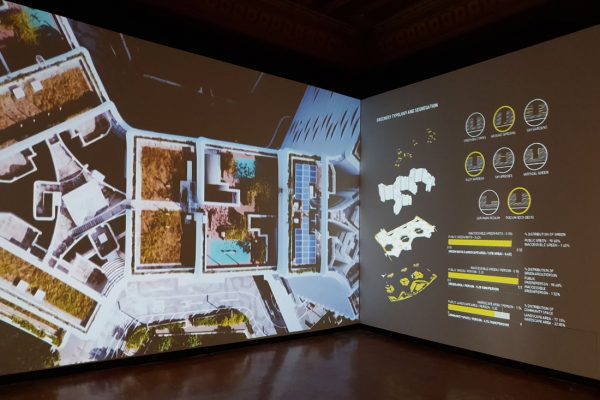
Projection of the Punggol Waterway Terraces I case study
Visual presentations are augmented by a series of interviews with architects and landscape architects involved in these projects such as Tan Shao Yen of CPG Consultants, Richard Hassell of WOHA and Henry Steed of ICN Design International. These provide insights to the inspiration, rationale and design concepts behind the buildings.
The FCL’s Dense and Green Building Typologies research project investigates the environmental, social, urban, architectural and economic benefits of large buildings with integrated green spaces in high-density contexts. In Singapore, these benefits are being explored with new typologies for high-density contexts that include public spaces, extensive sky terraces, sky bridges, vertical parks, roof gardens, and other ‘green’ components.
A key aspect of the Venice exhibition is to show how density and sustainability can be synergistic and mutually dependent, not contradictory. There is the capacity to to produce ‘vertical cities’ in which the building section becomes part of larger urban ecosystems such as parks, gardens and river networks.
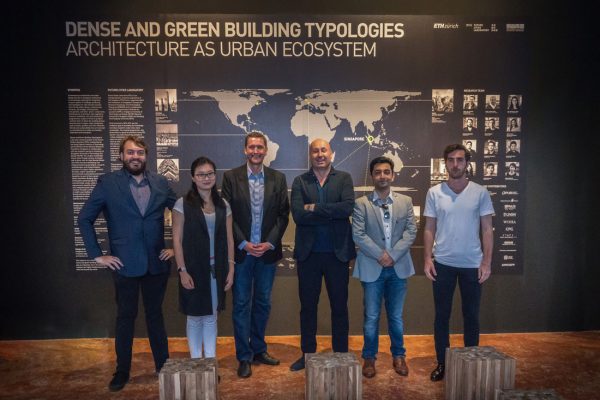
Research team (L-R): Richard Belcher, Michelle Yingying Jiang (Project Coordinator), Thomas Schroepfer (Principal Investigator), Sacha Menz (Co-Principal Investigator), Mayank Kaushal and Emek Erdolu
The Venice Biennale runs until 25 November 2018.
All images courtesy of the Future Cities Laboratory.
The Future Cities Laboratory Dense and Green Building Typologies Team (ETHZ and SUTD) consists of Thomas Schroepfer (Principal Investigator), Sacha Menz (Co-Principal Investigator, Michelle Jiang (Project Coordinator), Richard Belcher, Emek Erdolu, Srilalitha Gopalakrishnan, Mayank Kaushal, Thibault Pilsudski, Prashanth Raju, Esther Suen and Jonathan Tan.
INDESIGN is on instagram
Follow @indesignlive
A searchable and comprehensive guide for specifying leading products and their suppliers
Keep up to date with the latest and greatest from our industry BFF's!

A longstanding partnership turns a historic city into a hub for emerging talent
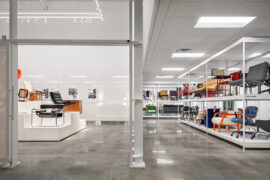
The undeniable thread connecting Herman Miller and Knoll’s design legacies across the decades now finds its profound physical embodiment at MillerKnoll’s new Design Yard Archives.

For Aidan Mawhinney, the secret ingredient to Living Edge’s success “comes down to people, product and place.” As the brand celebrates a significant 25-year milestone, it’s that commitment to authentic, sustainable design – and the people behind it all – that continues to anchor its legacy.
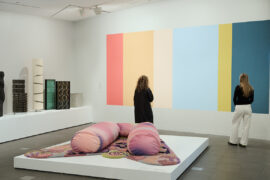
At the NGV’s Making Good: Redesigning the Everyday, design becomes a force for repair. From algae-based vinyl to mycelium earplugs, the exhibition proves that rethinking the ordinary can reshape our collective future.
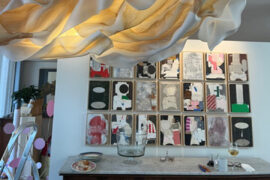
Held in a private Melbourne residence, Fletcher Arts’ annual exhibition unites over 30 Australian artists and designers in a setting where art meets architecture.
The internet never sleeps! Here's the stuff you might have missed
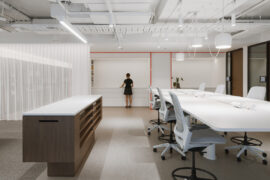
GEYER VALMONT is launching an innovation hub designed to improve existing interior design capability through enhanced ways of working and industry-leading technology products.
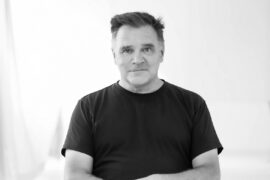
In this comment piece, COX Principal David Holm reflects on Carlo Ratti’s curatorship in which climate, colonisation and gender equity took centre stage at the Venice Biennale.